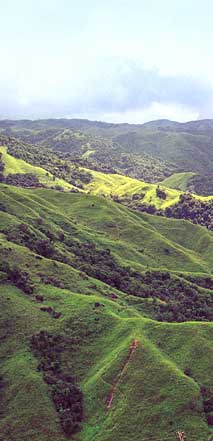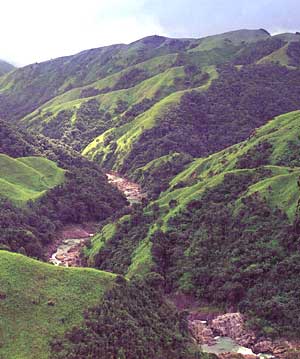GROUNDFACTS | MEGHALAYA
The nutrient-deficient soil in these forests is closely bound to the nutrient cycle that the forest ensures. Research in the Mawsmai forests at Cherrapunjee in the East Khasi Hills shows that the trees’ fine root systems in the surface layer of soil, particularly the part located over the mineral soil, facilitate rapid uptake of nutrients released by decomposing forest litter. In addition, the roots also intercept nutrients from rainfall wash-offs. The presence of fine root biomass of up to a maximum of 14,000 kg/ha in the soil to a depth of 30 cm is therefore crucial in mopping up the nutrients and keeping the soil alive, so to speak.
About 40 per cent of this fine root system lies in the top 10 cm of the soil surface, of which the fine root biomass over the mineral soil comprises about six per cent. The root structure is so fine that it can sometimes be as fabrile as 6 mm in diameter. The proliferation of root systems during monsoon helps in lapping up the nutrients that are released from decomposition, which are then recycled.
But this nutrient cycle is as brittle as a dry leaf. Anybody walking out of the groves of Mawsmai or Mawphlang ka law kyntang can see the contrast, which hits one suddenly as the bright sunlight. Outside the sharp boundary of the grove is nothing but hundreds of metres of flat grassland stretching right up to the homesteads. Besides a football goalpost, standing oddly where the forest must have stood sometime back, the ancient megaliths and the icon of the rooster, which is the emblem of the Khasi kingdom, are the only vertical outcrops here. Once cut, the forest must have refused to come back. Once the equilibrium was breached, the soil-litter relation broke down. Before long, the monsoons blew away the topsoil nutrients and with no roots left to replenish the soil, the forest degraded into grassland, and at places into wasteland. The plants that would have regenerated the land in ideal conditions are now unable to find nourishment. Research has found that 66 of the 79 groves that have
been documented in Meghalaya, covering an Of the 79 documented groves, 32 are found in the East Khasi Hills, 13 in the West Khasi Hills, 15 in the Jaintia Hills, eight each in the East and West Garo Hills and three in Ri Bhoi. Twenty of these are larger than 100 ha, while the smallest measures only 0.01 ha. One must remember, though, that these are only the ones that have been documented, or in other words, "discovered". How many more exist in the Khasi, Garo and Jaintia hills could be anybody’s guess. Unlike in most parts of India, more than 90 per cent of Meghalaya’s forests are owned, not by the government, but by communities and individuals. These forests are classified on the basis of usage and ownership patterns and not all types are accorded same degrees of protection. A complex ownership pattern exists by which forest patches can be managed by clans, a set of villages, a priest or a king. Myth or prudence?
Beh dien khlam in local parlance
means "chasing away the plague". After preliminary sacrifices at the outskirts
of the town and at the sacred grove, a minor sacrifice is held at the lyngdoh’s
house. On an appointed day, people gather at the groves to cut down the dieng khlam
or plague trees, which are then left lying in the forest for a few nights. Amidst a lot of
fanfare, these trees are then kept in the market for one night, then brought to the
localities where they are erected on the ground as groups of men perform the Each region, tribe and sub-tribe has its own version of rituals, taboos and ceremonies that are built around the groves. At first glance the rituals that protect the groves and the ecology of these forests look completely unrelated to each other. But in these forests, first impressions can be deceptive, like its multi-coloured poisonous fungi. Perhaps the communities were aware, as research has shown, that sacred groves work brilliantly as safety forests, a patch of woods kept secure and untouched as a gene pool. They could afford to continue to use the other patches of forest (at times for shifting agriculture), safe in the knowledge that they could always be replenished from the seeds of the sacred grove. Perhaps this act of dedicating a patch of forest to the spirits was an ecologically conscious one. Could the village elders have known that the small patch of forest could be bursting with biodiversity? Today, research has shown that just three sacred groves close to Jowai host 20 plant species, such as the drimycarpus racemosus, spondias axillaris and styraxhookerii, which have not been reported elsewhere in the Jaintia Hills. About 395 species, 250 genera, and 108 families comprising pteridophytes, gymnosperms and angiosperms have been found in these three groves alone. Of them, 54 species were endemic to the region, while 31 were rare and 38 were primitive. It is hard to find proof in the region’s oral history that the people consciously committed these forests to be refugia. It is so much simpler to find evidence corroborating the hypothesis that protection of the biodiversity was incidental to other purposes and causes. This is what some anthropological findings suggest, in Meghalaya as well as elsewhere in India. Most scientists date the origin of the sacred groves to the pre-agrarian age. Historian D D Kosambi in 1962 talked of a pattern that is now being discovered elsewhere. The groves were, he believed, concentrated along pre-agrarian trade routes and crossroads. B K Roy Burman, Delhi-based anthropologist, says, "These sacred groves [in Meghalaya] were created as refugia not for the biodiversity but for the king-priests to extend protection to the traders. There is a long recorded tradition of this all over the Indo-China region. Traders, wherever they travelled on international routes, always sought the local kings’ protection. The syiems and nokmas of Meghalaya built up theses sacred groves alongside the routes, providing a secure cover and taxing them in return for protection. The biodiversity richness was incidental and not essential at a time when the forests must have been thick anyway."
Questioning the conscious intent of a community means questioning its entire ethos. The debate about pre-agrarian people being either noble savages or just occassional prudent users who realised the value of their environment continues unabated. It is entirely possible the earlier settlers protected these groves for their own reasons and the settled clans then found their existence integrally tied to the fragile ecosystem they had created. Definitive answers are hard to come by as research into these aspects remains minimal and sketchy at best. There are other twists to the primary question of ecological consciousness. Research conducted by A Pompa-Gomez in the tropical forests that were inhabited by the Mayans in Central America shows that these forests were not protected despite the people but were actually shaped by the people themselves. Pompa-Gomez writes, "The complexity of the forest is already clear, both in number of species and in temporal and spatial arrangement. One of the most striking features that has emerged from studies of lowland tropical Mexico has been the importance of human intervention and management in the development of the forests." Interestingly, the region Pompa-Gomez studied had been more densely populated in the Mayan era than it is today. Agro-forestry probably provided these populations much of the support they needed. He notes further, "It [is] also clear that the forests we see today are largely the result of human selection and management. We have inherited the complex forests from the agro-foresters of the past, but we have not inherited their knowledge and skill. The preliminary evidence suggests that the Maya may have been as active as the Kayapos of Amazonia, who selected the trees used in creating the tree islands (apete) of the savannah from an area larger than Western Europe." The tribes that migrated to Meghalaya could have sculpted the forests in the region just as well. Researchers are already aware that the jhum cultivation systems in the hills of the region uses its natural resources intelligently to jump-start secondary succession on fallow lands — the natural regeneration process that begins once the forest land has been disturbed or degraded. Another clue that hints at the fact that the groves are primarily a product of human intervention is the ecological theory of species population dynamics. Claude Garcia of the French Agricultural Research Centre for International Development, France, explains, "A higher level of biodiversity richness is usually found in ecosystems that have been disturbed and not at systems that exist in absolutely pristine states." The negative connotation to the word "disturbance" perhaps arises out of studying Indian forests too much under the spectre of European forestry models.
Today matters more The answers lie in the flux of economy. The regions that
once remained distant from the market economies |
||||||||||||
|

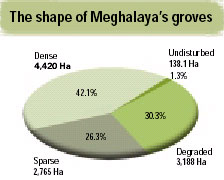 Sacred groves like the one in Raliang can be a paradox. At the macro-level, it is
a forest grown to its prime, an ecological pinnacle. From a distance, it looks a
picturesque but seemingly impenetrable dark green mass that has remained unchanged for
years. But a walk into the heart of a grove reveals a contrast. Each square foot of the
soil underneath this thick canopy plays its own part in a grand epic that unfolds each
day: a thousand chemical and biological processes, abetting and countering one another,
that maintain a fragile and dynamic equilibrium. All to preserve the apparent serenity
that a first impression creates. This is an energy system so finely tuned that it cannot
but leave one wondering if the evolutionary process can actually give rise to such
complexity.
Sacred groves like the one in Raliang can be a paradox. At the macro-level, it is
a forest grown to its prime, an ecological pinnacle. From a distance, it looks a
picturesque but seemingly impenetrable dark green mass that has remained unchanged for
years. But a walk into the heart of a grove reveals a contrast. Each square foot of the
soil underneath this thick canopy plays its own part in a grand epic that unfolds each
day: a thousand chemical and biological processes, abetting and countering one another,
that maintain a fragile and dynamic equilibrium. All to preserve the apparent serenity
that a first impression creates. This is an energy system so finely tuned that it cannot
but leave one wondering if the evolutionary process can actually give rise to such
complexity. 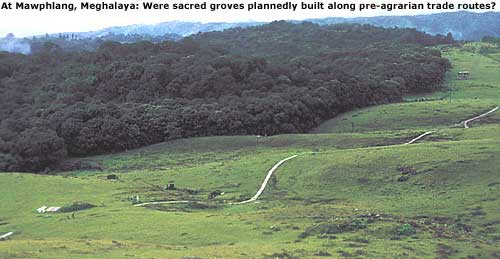
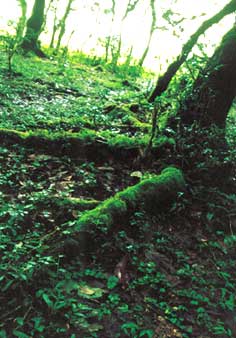
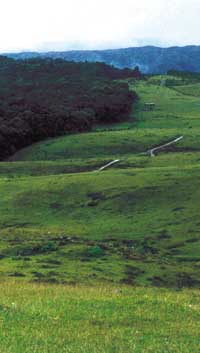 estimated 10,251
ha, are located in the catchment areas of major rivers or rivulets. A number of perennial
streams originate from 58 of these groves, covering an area of 9,621 ha. Thirty-eight
sacred groves, covering 6,454 ha, are located on steep hill slopes. The Lum
Shyllong-Nongkrim sacred groves, for instance, are the source of as many as eight streams
that supply water to Shillong, the capital of the Meghalaya.
estimated 10,251
ha, are located in the catchment areas of major rivers or rivulets. A number of perennial
streams originate from 58 of these groves, covering an area of 9,621 ha. Thirty-eight
sacred groves, covering 6,454 ha, are located on steep hill slopes. The Lum
Shyllong-Nongkrim sacred groves, for instance, are the source of as many as eight streams
that supply water to Shillong, the capital of the Meghalaya. 